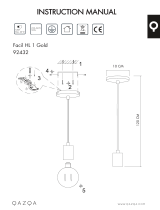
6
1. Introduction
1.1 History The development of linear fluorescent goes back to the thirties of the 20th
century. The diameter of 51mm was very voluminous. However, better
efficiency did not come up before the fifties.
The improvements according to the luminous flux and lifetime with the T12
lamp (38 mm diameter) made an economic and even outdoor application
possible. There were continuous improvements for optimizations as for
example Amalgamtechnology. In this term fluorescent lamps were operated
by conventional control gears (CCG).
The decisive breakthrough was at the end of the 70s and early 80s. In the
year 1978, a new T8/∅ 26 mm- lamp generation started to replace
T12/∅38mm- fluorescent lamps. New phosphors with higher resistance
came into the market. Nowadays known under triband-phosphor (LUMILUX
light colours). The diameter of the lamps was reduced from 38mm to 26mm
however the length was kept with 59, 120 and 150 cm as the sockets G13.
The new wattage of 18, 36 and 58 W was advantageous as it was a
reduction of at least 10% compared to the T12/∅38 mm lamps in 20, 40
and 65 W.
This was also the hour of birth for the Electronic Control Gears (ECG). First
the circuits were in a instant start mode what also was called softstart up to
the programmed or preheat start. Together with modern Electronic Control
Gear QUICKTRONIC T8/∅26 mm- fluorescent lamps became even more
efficient and longer lasting. In addition, the thermal behavior of the
luminous flux was improved.
The T8-system was permanently improved as the example of the triband-
phosphor shows with a very high service life of the fluorescent lamp.
In 1995, the next milestone of fluorecent lamp development saw the
introduction of new FH...HE (High Efficiency) systems to the market. With
the reduced diameter of 16 mm only the lamp was designed. It is available
in 14, 21, 28 and 35 W with the G5 sockets. It is 50 mm shorter as the T8
fluorescent lamps.
T5 fluorescent lamps only can be operated by Electronic Control Gear. So
the light output and the life time of the lamp were designed from the
beginning to an optimum of up to 104 lm/W. The maximum luminous flux of
the T5 lamps is at 35 °C compared to 25 °C at T8 or T12 lamps. The
reduced lamp diameter of 16 mm as the maximum lumen output at 35 °C
are the relevant feature for a higher efficiency of the fixture.
1879
Kohlefaden-Glühlampe
von Thomas A. Edison
Incandescent lamps with carbon filament
by Thomas A. Edison
1910
Glühlampen mit Wolfram-Wendel
Incandescent lamps with tungsten coils
1925
BILUX®Zweidraht-Scheinwerferlampen
BILUX®two-wire headlight lamps
1931
Natriumdampf-Niederdrucklampen
Low-pressure sodium vapor lamps
1933
Quecksilberdampf-Hochdrucklampen
High-pressure mercury vapor lamps
1936
Leuchtstofflampen
Fluorescent lamps
1954
XBO Xenon-Hochdruck-
lampen
XBO high-pressure
xenon lamps
1968
VIALOX® NAV Standard
Natriumdampf-Hochdrucklampen
VIALOX®NAV Standard
high-pressure sodium vapor lamps
1968
POWERSTAR HQI
Halogen-Metalldampflampen
POWERSTAR HQI
metal halide lamps
1970
HMI METALLOGEN®Lampen
HMI METALLOGEN®lamps
1971
BILUX®H4
Halogen-Zweidraht-Scheinwerferlampen
BILUX®H4
two-wire halogen headlight lamps for auromobiles
1973
HALOSTAR Niedervolt-Halogenglühlampen
HALOSTAR low-voltage tungsten-halogen lamps
1979
LUMILUX®
Leuchtstofflampen
LUMILUX®
fluorescent lamps
1980
EVG QUICKTRONIC®DE LUXE / ECG
QUICKTRONIC®DE LUXE
1982
OSRAM DULUX®L
Kompakt-Leuchtstofflampen
OSRAM DULUX®L
compact fluorescent lamps
1984
DECOSTAR Niedervolt-Halogenglühlampen
mit Kaltlichtreflektor
DECOSTAR low-voltage tungsten-halogen
lamps with dichroic reflectors
Anwendungsbereich: AC/DC 198 V bis 254 V
Geeignet fr Batteriespannungen 154 V bis 276 V
Zur Verwendung in Anlagen nach VDE 0108 geeignet
Range of application: AC/DC 198 V to 254 V
Range of battery voltage: 154 V to 276 V
Suitable for emergency installations acc. to VDE 0108
Temp.-Test
tc = 70 C max.
class B
0712T201 OW2 Made in Germany
1
L
2
3
4
PL (W)UN (V)fN (Hz)IN (A)lta ( C)
1xL18 W1x16-2050
22050600,090,95 C
2400,0850,93 C OSRAM
1985
OSRAM DULUX®EL Kompaktleuchtstoff-
lampen mit elektronischem Vorschaltgerät
OSRAM DULUX®EL energy-saving lamps
with electronic control gear
1987
POWERSTAR HQI-T
Halogen-Metalldampflampen
POWERSTAR HQI-T
compact metal halide lamps
1991
D1 Gasentladungslampen
D1 gas discharge lamps
1993
COLORSTAR DSX-T 80W
Natrium-Xenonlampen
COLORSTAR DSX-T 80W
sodium xenon lamps
1993
FM Mini-Leuchtstofflampen / FM mini fluorescent
lamps
1995
FH Hocheffiziente Leuchtstofflampen / FH high-
efficient fluorescent lamps
1996
FQ Lichtstarke Leuchtstofflampe / FQ high power
fluorescent lamps
1997
OSRAM ENDURA Die elektrodenlose
Hochleistungsleuchtstofflampe
OSRAM ENDURA The high-performance
electrodeless fluorescent lamp

























